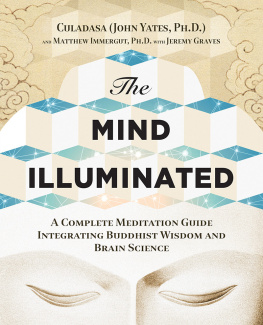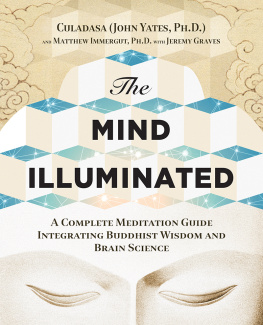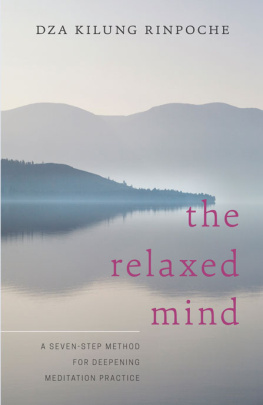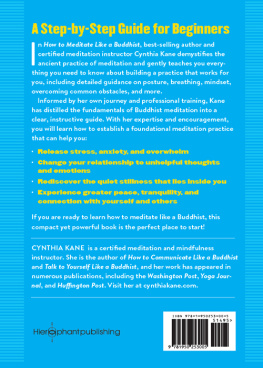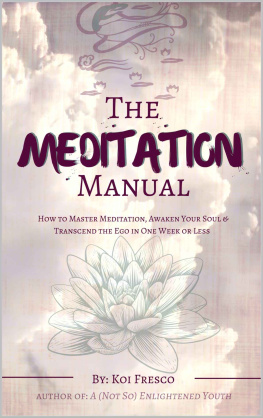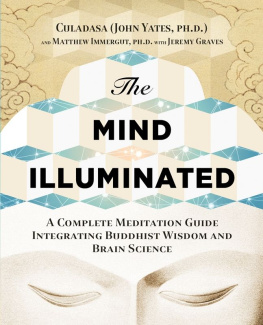Appendix A
Walking Meditation

W alking meditation is both a powerful practice in its own right and an indispensable complement to sitting practice. Too often its not taken seriously enough; we imagine a meditator to be someone who only sits cross-legged with eyes closed. But walking meditation is just as effective as sitting for developing stable attention and powerful mindfulness. Its even more effective for some things. The best way to make rapid progress is to combine the two.
The practices of walking and sitting meditation are essentially the same: stabilize your attention while sustaining or even increasing peripheral awareness. The only real difference is where you focus your attention. Here, you fix it on the sensations in the soles of your feet, rather than on the breath at the nose. Alternatively, you can use the sensations in the muscles, joints, and tendons of your legs as the meditation object. Walking, like breathing, is an automatic activity, and the ever-changing sensations with each step provide a continuous anchor for attention. At the same time, peripheral awareness stays open to whatever is happening in the internal and external world. Walking meditation offers a variety of opportunities for working with attention and peripheral awareness in different ways.
As a part of your daily practice, you can do walking meditation first to help calm your mind in preparation for sitting. Or you can walk right after sitting, which brings a high level of focused attention to the walking practice. You can also do walking meditation separately from sitting whenever its convenient. During meditation retreats, or on days set aside for more extensive practice, alternate walking and sitting practices. This gives your body a chance to limber up and recover from the effects of long periods of motionless sitting, but without interrupting your practice. Never treat walking meditation as a break from your practice. If you really do need to take a break, do something completely different, like going for a stroll or taking a nap.
The best location for walking meditation practice is outdoors. An open space where you wont be interrupted, such as a back yard, gardens, or park is perfect. A place with some sort of natural beauty is ideal, but not essential, since aesthetic enjoyment isnt the main point. A quiet city sidewalk also works quite well. Use a path you can follow easily, so you dont need to make decisions about where to go as you walk. Otherwise, just plan your path in advance and make adjustments as needed. Of course, you can also walk indoors. Choose a large room or a hallway that allows you to go about 20 feet or so before you have to turn around. You can also just walk a circular path in a smaller room.
Begin doing the walking practice for 15 to 30 minutes at a time. In general, you will likely find that 30 minutes is a good period. As you get into the practice, you may find you want to walk for an hour or more at a time. Walking meditation is easy and relaxing, so the biggest constraint on how long you walk each day is simply time and opportunity.
Walking Through the Stages
Each technique used in walking meditation builds on the skills youve already developed in your sitting practice. Since the skills being developed in walking meditation are the same as with your sitting practice, the progression of walking techniques is described in the same sequence. This is helpful for organizing a discussion such as this, but theres actually a lot of latitude for customizing these practices according to your own experience. Still, no matter which technique you happen to use, always remember to keep an attitude of interest, exploration, relaxation, and enjoyment. The more meditation becomes associated with feelings of happiness and pleasure, the stronger your motivation and the faster your progress.
Stage One: Staying in the Present
Stage One walking meditation is simple and relaxed, and quite like the Four Step Transition described for Stage One sitting meditation. To begin with, as in Step One of the transition, its all about exploring the present moment. You allow your attention to move freely while keeping your awareness open as you walk. The only restriction is to stay fully in the present, the here and now. By the end of this Stage, however, your attention will be continuously focused on the sensations of walking, just like with Step Four of the transition to the breath.
Exploring Walking
Before you even begin the formal walking practice, you first need to experiment with various walking speeds while carefully observing their differences. Begin by walking at a normal, unhurried pace. Notice how automatic the process is, barely needing any attention at all. The mind is free to go where it will. At first, youll notice all sorts of things in your surroundings, but youll quickly find yourself caught up in thoughts and memories that take you away from the present. When you catch your mind wandering, simply bring yourself back to the present by focusing your attention on the sensations in your feet. For the next few steps, keep your attention on your feet to help you stay in the here and now. Notice how similar this is to sitting meditation: you can be aware of everything around yousights, sounds, and other sensationswhile keeping your attention on your feet. Now release your attention from the feet, allowing it to continue exploring the present as you walk at a normal pace.
Next, speed up as if you were in a hurry to get somewhere. Notice how at first you need to pay more attention than before to direction, obstacles, and footing, but then peripheral awareness quickly takes over that job. Once that happens, youll soon find yourself thinking of things totally unrelated to where you are and what you are doing, and may even forget that youre supposed to be meditating. Its much more difficult to keep yourself in the present by attending to the sensations in your feet: theyre just too brief and changing to serve as an effective anchor. The full activity of walking, howeverarms swinging, legs moving, torso pivoting, etc.works far better as an anchor for attention when walking quickly. You dont need to spend much time doing fast-walking meditation, just enough to learn the different effects it has on the way attention and awareness work together, and on your ability to stay in the present.
Finally, try walking very, very slowly, as if you were trying to sneak around. Notice the loss of fluid movement, and how almost every detail of the process needs attention and deliberate control. Note especially how walking very slowly not only helps keep you in the present, but also naturally causes attention to go to the feet; when your attention strays for even a few moments, wobbling, instability, and loss of balance quickly bring you back to the here and now.
Again, youre just experimenting to familiarize yourself with the effects speed has on attention, awareness, and your ability to stay in the present. This will be very useful information to have at different Stages of walking practice, allowing you to adjust your speed for different purposes. Most will find one or two sessions of experimenting with different speeds is enough, but feel free to continue as long as youre still learning from it.
The Practice
To begin your formal practice, choose a comfortable pace, one that is slow enough to easily observe changing sensations in the soles of your feet, but fast enough to be mostly automaticwhat might be called slow normal. Spend more and more time attending to the sensations in your feet as you walk. They will eventually become your primary meditation object, but dont restrict your attention to them just yet. For now, your primary objective is just to remain in the present as you walk. This means your attention can move from your feet to anything happening in the moment that you find interesting. However, these must always be intentional movements of attention! If you are outside, there will be sounds, interesting and attractive visual objects, and odors.

